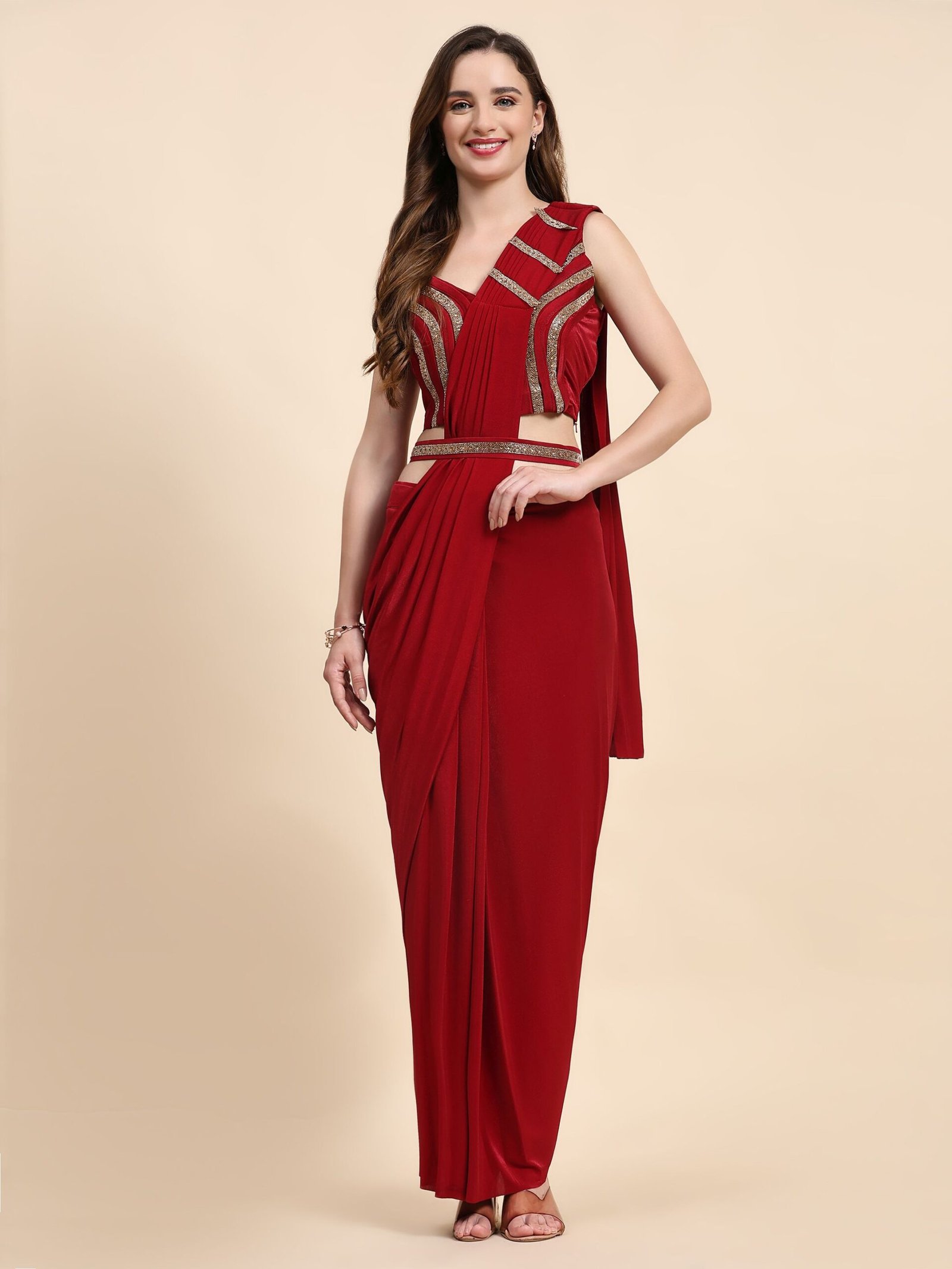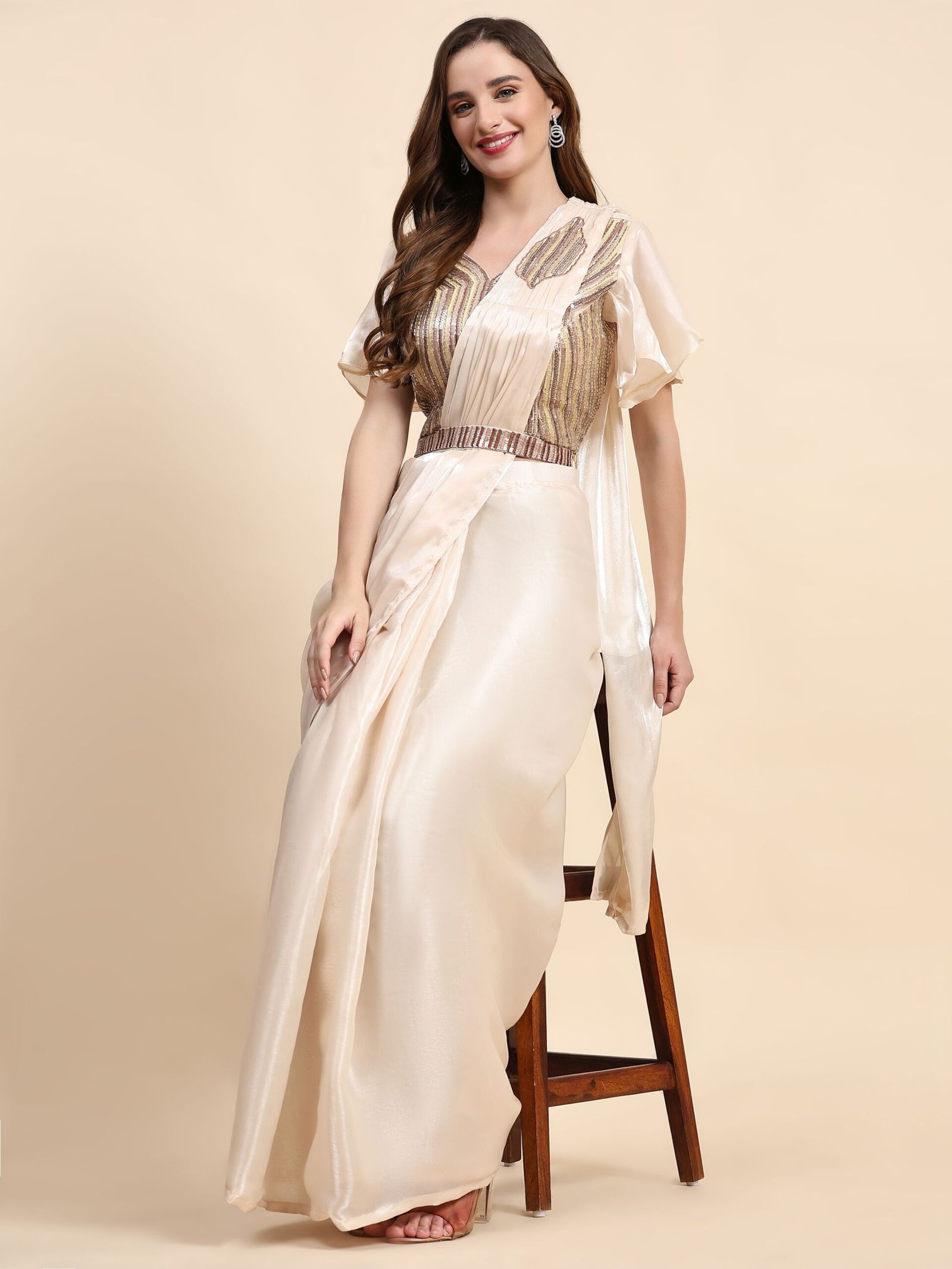A Saree For Women, also spelled sari, is a traditional garment worn by women in South Asia, particularly in India, Bangladesh, Nepal, and Sri Lanka.
It is a long piece of cloth, usually ranging from five to nine yards in length and two to four feet in width, which is wrapped around the body in various styles. The saree is draped over a petticoat and typically paired with a fitted blouse called a choli.
Key Elements of a Saree:
Fabric: A vast range of materials, such as silk saree, cotton saree, chiffon saree, georgette saree, crepe, and more, are used to make sarees. Each fabric offers a different look and feel, suited for different occasions and climates.
Blouse (Choli): The blouse is a short top that is worn underneath the saree. It can be of varying sleeve lengths and neck styles, often matching or complementing the saree.
Petticoat: A skirt-like garment worn under the saree to help tuck and secure the drape.


Draping Styles:
There are numerous ways to drape a Saree For Women, with styles varying by region and occasion. Some popular styles include:
Nivi Style: The most common style, originating from Andhra Pradesh, where the saree is tucked into the petticoat, wrapped around the waist, and then draped over the shoulder.
Bengali Style: Known for its distinctive draping, often without pleats at the front, with the pallu (the end part of the saree) thrown over the left shoulder.
Gujarati Style: The pallu is brought from the back to the front over the right shoulder.
Maharashtrian Style: A more complex drape, often without a petticoat, where the saree is wrapped between the legs and tucked at the back, resembling dhoti pants.
Cultural Significance:
The saree is not just a garment but a symbol of cultural heritage and tradition. It is worn during various ceremonies, festivals, and everyday life, with specific sarees and draping styles associated with different social and cultural contexts. Sarees can range from simple, everyday wear to elaborately embroidered and decorated ones for weddings and special occasions.
Modern Adaptations:
In contemporary fashion, sarees have seen various modern adaptations.
Designers experiment with fabrics, draping styles, and blouse designs to give the traditional attire a contemporary twist while retaining its elegance and cultural essence.
The saree, a traditional garment synonymous with grace and elegance, has been an integral part of South Asian culture for centuries.
Worn by women across India, Bangladesh, Nepal, and Sri Lanka, the saree is much more than just a piece of clothing; it is a reflection of rich heritage, regional diversity, and timeless beauty.
Historical Roots of the Saree
The history of the saree can be traced back to ancient civilizations, with its origins deeply rooted in the Indian subcontinent.
Early references to saree-like garments can be found in ancient Hindu scriptures and sculptures, indicating that this style of draped clothing has been prevalent for over 5,000 years.
Fabric and Weaves: Diversity in Drapes
The variety of fabrics and weaving techniques used in saree-making is vast, showcasing the cultural and regional diversity of South Asia. Silk, cotton, chiffon, georgette, and crepe are some of the most commonly used materials.
Each region has its distinctive style, such as the luxurious Kanchipuram silk from Tamil Nadu, the delicate Banarasi silk from Varanasi, and the vibrant Pochampally sarees from Telangana.
The Anatomy of a Saree
A saree typically measures between five to nine yards in length and about two to four feet in width. It is draped around the body in various styles, with one end (pallu) draped over the shoulder. This versatile garment is usually paired with a fitted blouse (choli) and an underskirt (petticoat) to help secure the drape.
Draping Styles: A Regional Tapestry
The saree can be draped in numerous styles, each associated with a specific region or community. Some popular draping styles include:
Nivi Style: The most common style, originating from Andhra Pradesh, with pleats in the front and the pallu draped over the left shoulder.
Bengali Style: Characterized by its simplicity, with the saree wrapped around the body and the pallu draped over the left shoulder without pleats.
Maharashtrian Style: Resembling a dhoti, this style involves tucking the saree between the legs and securing it at the back.
Gujarati Style: The pallu is brought over the right shoulder from the back and spread across the chest.
Cultural Significance: Beyond Fashion
The saree holds immense cultural and symbolic significance in South Asian societies. It is worn during various ceremonies, festivals, and rituals, often carrying deep cultural meanings. For instance, red sarees are traditionally worn by brides in many parts of India, symbolizing prosperity and fertility.
Modern Adaptations: Tradition Meets Trend
In contemporary fashion, the saree has evolved to incorporate modern elements while retaining its traditional charm. Designers experiment with fabrics, embellishments, and draping styles to create innovative saree designs. Modern sarees may feature pre-stitched pleats, lighter materials, and trendy blouse patterns, catering to the preferences of today’s women.
The Saree on the Global Stage
The saree has gained international recognition, celebrated for its elegance and versatility. It is often featured in global fashion shows and worn by celebrities, symbolizing the rich cultural heritage of South Asia. Initiatives like “Saree Day” and international exhibitions have further popularized this traditional attire worldwide.
Preserving the Legacy: Handloom and Artisans
The saree industry supports millions of artisans and weavers, particularly in India. Preserving traditional handloom techniques is crucial for maintaining the cultural heritage associated with sarees.
Efforts by governments and NGOs aim to promote sustainable practices, fair trade, and the global reach of handloom sarees, ensuring that this art form continues to thrive.
Conclusion: A Timeless Attire
The Saree For Women is more than just a garment; it is a living tradition that embodies the rich cultural heritage of South Asia. Its enduring appeal lies in its versatility, elegance, and the stories woven into each piece.
Whether worn for a festive occasion or as everyday attire, the saree continues to be a symbol of grace and beauty, bridging the past with the present and inspiring future generations.

